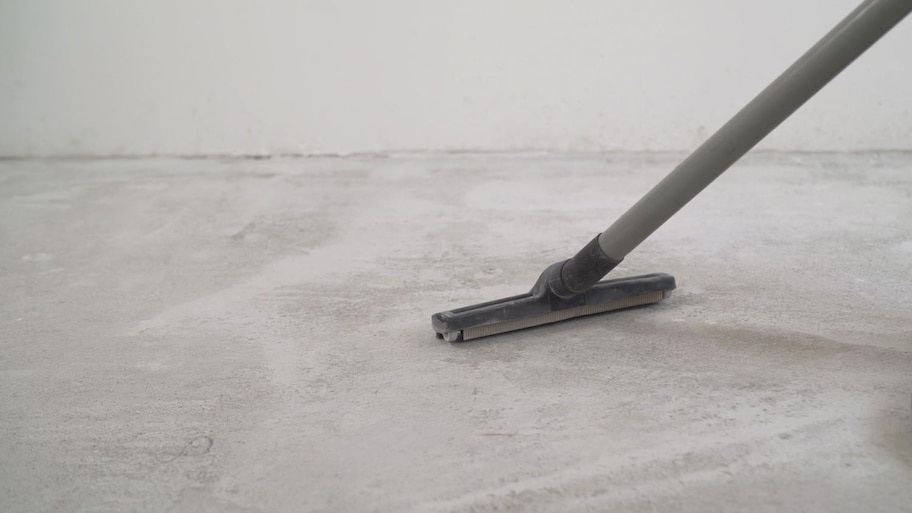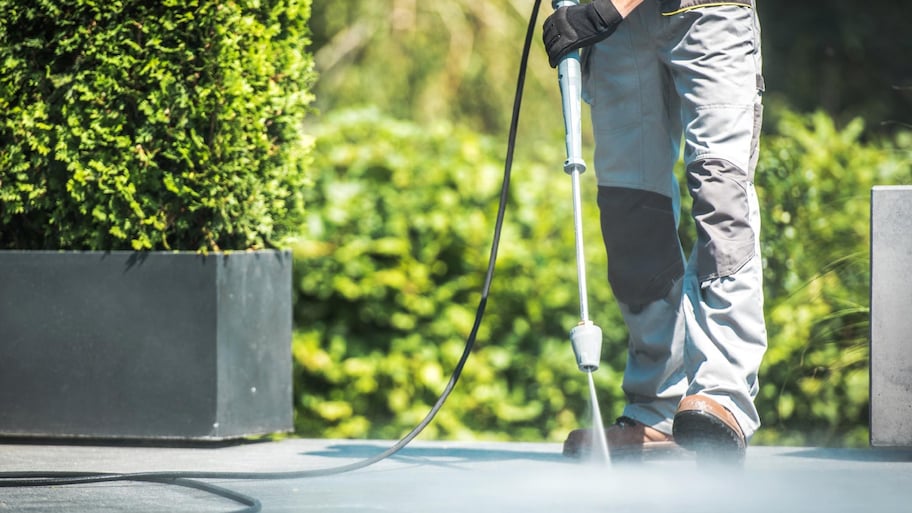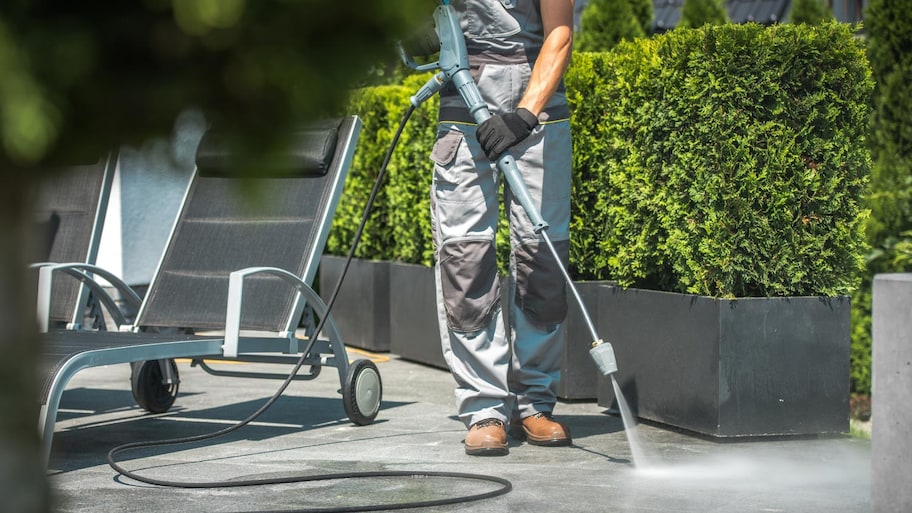Immaculate concrete is within your grasp
Concrete is everywhere, from your outdoor patio to the floors in your basement. This durable, inexpensive, and low-maintenance material is rarely celebrated, but is always there when you need it. Despite concrete’s amped-up durability, it’s susceptible to stains that require cleaning. Here are the best ways to get your concrete clean, pristine, and filled with sheen.
Why Do I Have Dirty Concrete in My Home?

File this under “life happens.” Concrete withstands a lot, but it’s not immune to dirt, debris, and grime—and the stains they create. Concrete typically resides in out-of-the-way parts of the home that don’t receive too much cleaning, such as the basement or the garage. Also, this material makes up driveways and patios, both of which are outside and subject to the elements. In the case of driveways, vehicles leak and cause stains over time. Find the source of the stains to keep your concrete clean in the long term.
How Much Does It Cost to Clean Concrete?
DIY concrete cleaning costs anywhere from zilch to $100, depending on whether you have to buy cleaning solution and tools. Hiring a pro to clean your concrete varies in cost, depending on where they’re cleaning. Hiring a pro to power wash a driveway or patio costs between $100 and $200. Looking to clean concrete slabs in the basement or garage? Hiring a professional housecleaner costs $30 to $50 per hour. Of course, these prices also vary according to the severity of the issue.
How to Prep for Concrete Cleaning
No matter which cleaning method you choose, start by removing any and all items from the area. For instance, take away potted plants, furniture, and decorative items from an outdoor patio and move any cars parked on a concrete driveway. Also, remove any weeds sprouting up from exterior concrete. If cleaning a concrete basement, move everything from one side of the room to the other to start working in sections. Switch it back to finish the work.
Inspect the concrete for chips and cracks before starting to clean. Hire a local concrete repair pro to fix it up, if necessary. Finally, perform a spot test with your first choice of cleaning product at the very beginning of the process. Look for any discoloration caused by the cleaning solution. If there is no discoloration, it is safe to use. Move on to another cleaning method in the case of a worrisome result.
How to Clean Concrete
The most important thing to remember here is to start gently. Not all concrete slabs are created equal, especially when you mix in sealant and other chemical agents. If you happen to know if your concrete was sealed, when it was sealed, and, most importantly, what it was sealed with, keep that in mind before trying some of the harsher cleaning methods listed below. The methods for cleaning unsealed brushed concrete, for instance, differ from those used to clean epoxy-coated concrete.
With this in mind, this list of concrete-cleaning methods starts with the gentlest option first and moves on from there.
Use a Vacuum

A powerful home vacuum is an effective way to conduct your yearly concrete cleaning routine, especially if the slabs are free from stains.
Suck up any debris, dirt, weeds, and gunk with the vacuum.
If you find stains during the vacuuming process, leave them alone and move to the next cleaning method.
Treat Small Stains With Detergent
No matter the sealant type, concrete reacts well to regular liquid laundry detergent and water.
Spot-treat small stains with this mixture. Pour the soap and water solution directly onto the stain.
Use a stiff nylon brush to scrub the area until the stain dissolves. Do not use a wire-bristle brush, as these scratch concrete.
Rinse the area with water and let it dry before moving any items back in.
Use Vinegar or Baking Soda
If the liquid detergent fails to remove the stains, boost your cleaning power by adding white vinegar or baking soda to the solution.
Scrub vigorously using the nylon brush and rinse clean with a bucket of water before allowing the area to dry.
Repeat if necessary.
Pressure Wash the Area

For stubborn concrete stains, you can purchase an attachment to turn your garden hose into a pressure washer, rent a pressure washer from the hardware store, or hire a local pressure washing service. Of course, this method is for outdoor use only, unless you want to go for a swim in your basement.
Wear safety goggles while cleaning and avoid accidentally spraying windows, plants, and other fragile items.
Fill the pressure washer’s soap reservoir with a dedicated concrete cleaner, which is available online or at hardware stores.
Work slowly and carefully, stepping up the water pressure only as needed to avoid damage. Concrete can withstand plenty of pressure, but other materials cannot.
If cleaning a large area that is primarily concrete, feel free to crank the washer up to around 3,000 psi.
Once finished, allow the area to dry before retrieving plants, furniture, and other items.
Use a Commercial Cleaner
Concrete is porous, which is why some stains are so stubborn. To step up your game to clean indoor concrete, use a commercial cleaning product, which is available online and at hardware stores. Read the label for detailed instructions on how much water to add.
Scrub the concrete with a stiff bristle nylon brush. Again, refrain from using a wire brush here to minimize scratching.
If cleaning a garage floor, hit the area with a high-pressure hose to lift up the stains and allow the area to dry completely.
If cleaning a basement or another indoor spot, pour a bucket of water over the concrete to lift up the stain, assisting with some dry rags.
How to Keep Concrete From Staining
Once your concrete is clean as a whistle, follow some common-sense guidelines to keep the concrete from staining in the future.
Clean your concrete every year. Active driveways require twice-yearly cleanings, as vehicles tend to leak unsightly fluids when parked.
Reseal your concrete for stain resistance. There are many concrete sealant products to choose from, such as latex sealers, topical sealers, and special sealers designed just for stamped concrete, to name a few. Sealing concrete yourself is an easy DIY project, but you can also hire a pro.
Properly maintain your vehicles. Whether parked in a garage or on a concrete driveway, unmaintained vehicles leak fluids all over the place, staining whatever is below them.
Clean water leaks immediately. Concrete is porous, allowing plenty of room for mold and mildew to thrive when given enough moisture. Clear away spills and leaks to stave off nasty mold spores as soon as possible. This is particularly important for basements that don’t have access to freshly circulated air.
DIY vs. Hiring a Pro
Cleaning your own concrete will save you $30 to $50 per hour in labor fees, but it will cost you your free time and elbow grease. Your cost savings will also take a hit if you have to rent a pressure washer or buy commercial concrete cleaning solutions. That’s why many homeowners opt to hire a professional power washing service instead of going the DIY-route.
FAQs
What is making my concrete green?
If your concrete stains are green in color, it indicates the presence of mold or algae—which you should address right away. If left unattended, mold spreads to other areas throughout the home. Once free from mold and algae, seal your concrete to eliminate pores and gaps.
What if there is standing liquid on my concrete?
Remove the standing liquid before attempting any of the above cleaning methods. For small amounts of water, use rags, a bucket, and a mop. For larger areas of liquid, lay down cat litter or baking soda to soak up the water first. If you have extremely large pools of water sitting on your concrete, break out the wet vac and get to work.




